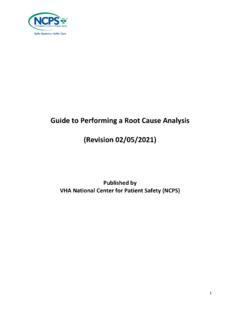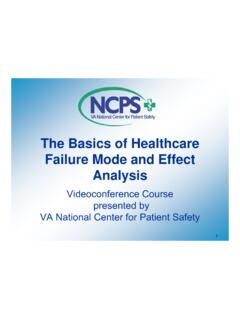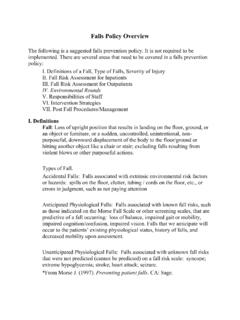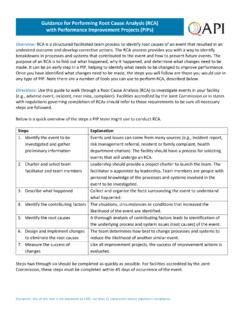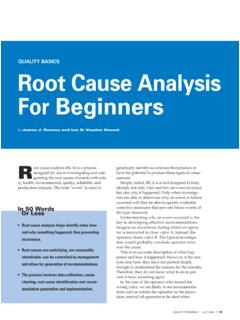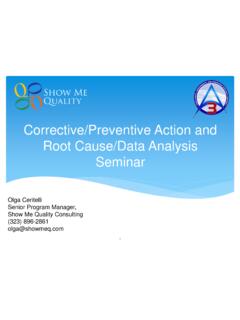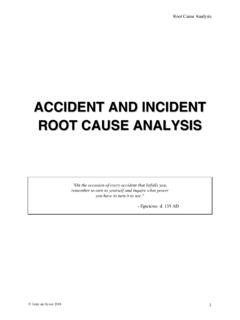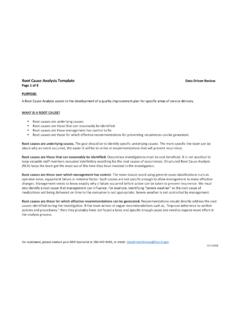Transcription of Root Cause Analysis (RCA) Process Steps.
1 VA National Center for Patient Safety RCA Step-By-Step Guide Page 1 root Cause Analysis (RCA) Process Steps. Getting Started: What happened? Why did it happen? What action can we take to prevent it from happening again? How will we know if the action we took made a difference? Step 1 charter/appoint RCA team. Step 2 Just in time training. Go to Analysis . Analysis : Step 1 Initial sequence of events. Step 2 identify information gaps (use triage questions). Step 3 Specify needed information (timeline and person responsible). Step 4 conduct fact-finding investigation (interviews, chart, literature reviews).
2 Go back and forth between Step 3 and Step 4 if needed. Step 5 synthesize information in final sequence of events. Step 6 identify root - Cause and contributing factors. Go to Taking Action. Taking Action: Step 1 identify actions implemented in similar past event(s). Step 2 develop action plan. Step 3 provide feedback to reporter. Step 4 identify what was learned and who needs to know. Step 5 create action plan for director, concur/non-concur. Step 6 final sign-off RCA and action plan. Go to Final Step. Final Step RCA advisor checks follow-up. VA National Center for Patient Safety RCA Step-By-Step Guide Page 2 root Cause Analysis (RCA) Step-By-Step Guide RCA is a Process for identifying the basic or contributing causal factors that underlie variations in performance associated with adverse events or close calls.
3 An RCA is a specific type of focused review that is used for all patient safety adverse events or close calls requiring Analysis . The term RCA is used to denote this Process specified in the Patient Safety Improvement Handbook Patient Safety reports and RCAs are confidential and privileged under 38 5705 and its implementing regulations. RCA teams focus on systems and processes, not individuals. They work to define: What happened? Why did it happen? What action can we take to prevent it from happening again? How will we know if the action we took made a difference? Getting Started Notes Charter/Appoint Team RCAs need to be initiated with a specific charter memorandum and the term root Cause Analysis used in documents to reaffirm they are protected and deemed confidential under 38 5705 and its implementing regulations.
4 A template is available in the Patient Safety Information system (nicknamed SPOT). The charter memorandum is signed by the facility director/designee. Teams usually consist of 4-5 people. Teams should be interdisciplinary in nature with involvement of those knowledgeable about the processes involved in the event. Having team members with different professional backgrounds generally supports creative thinking. The RCA team is comprised of VA staff. (At times, other individuals within the facility subject to the same restrictions and training applicable to VA employees, , residents, volunteers may participate; however they are responsible to follow the same confidentiality requirements of 38 5705.)
5 Please contact NCPS for specific clarification related to this issue of non-VA staff on RCA teams. Consider including leadership, clinical and administrative department chiefs on RCA teams to help obtain buy-in. NOTE: This is not to suggest that the team should consist solely of leaders and individuals with special knowledge of clinical or other processes thought to be associated with the adverse event or close call. Valuable contributions have been made by employees with little background in the clinical or other areas that were thought to be relevant at the outset of the RCA Process .
6 In the interest of objectivity, exclude individuals directly involved in the adverse event or close call as RCA team members. However, their experience and knowledge of the situation is vital to the RCA Process . Their interview and suggestions about how to prevent the situation from happening again may be invaluable to the RCA team. In cases where the facility director serves on the RCA team, final concurrence must come from the Veterans Integrated Service Network (VISN) director, or designee. Team members need to be available to participate; obtain support from supervisors prior to appointment on the RCA team.
7 If in the course of conducting an RCA it appears that the event under consideration is the result of an Intentionally Unsafe Act (a criminal act; a purposefully unsafe act; an act related to substance abuse by provider and/or staff; or events involving alleged or suspected patient abuse of any kind), the RCA team must refer the event to the facility director for appropriate further consideration as described in the Patient Safety Handbook. In such situations, the RCA team discontinues their efforts, since the facility VA National Center for Patient Safety RCA Step-By-Step Guide Page 3 Getting Started Notes director has the responsibility for any further fact finding or investigation.
8 Just in Time Training At the first RCA team meeting, an orientation of the RCA Process needs to be provided so all participants have a common understanding. Discussing the Triage questions and the strength of actions hierarchy is encouraged. Here s the link for triage questions: A simulated RCA video created by NCPS and provided to all PSMs may be part of the just in time training. Please contact NCPS if additional copies are needed. Assign roles for the leader, advisor and recorder. Decide on meeting dates and times to avoid potential delays. Review rules of behavior and expectations.
9 A greeting by a top manager may reinforce the importance of the team s work. Analysis Notes Initial Sequence of Events (Initial Flow Diagram) An initial sequence of events is an outline of the story that progresses chronologically from the first known fact through the final known fact. This initial sequence of events gives all team members the same understanding of what occurred which helps avoid differing interpretations of the same event. Establishing the series of events preceding the event is a critical step towards helping discover what caused the event and what to do to prevent it from happening again.
10 Include only those key events that are crucial to understanding what transpired. It is not necessary to include the amount of time that elapsed between events, but if the information is available it may provide valuable insights. The diagram/storyboard can be easily rearranged if sticky notes are used. Use tools and techniques (flip charts, brainstorming, parking lot for questions, etc.). The initial flow diagram should make clear what you know and what you don t know. Visit the scene of the event, use the equipment, and safely simulate what happened. Stick with the facts.
